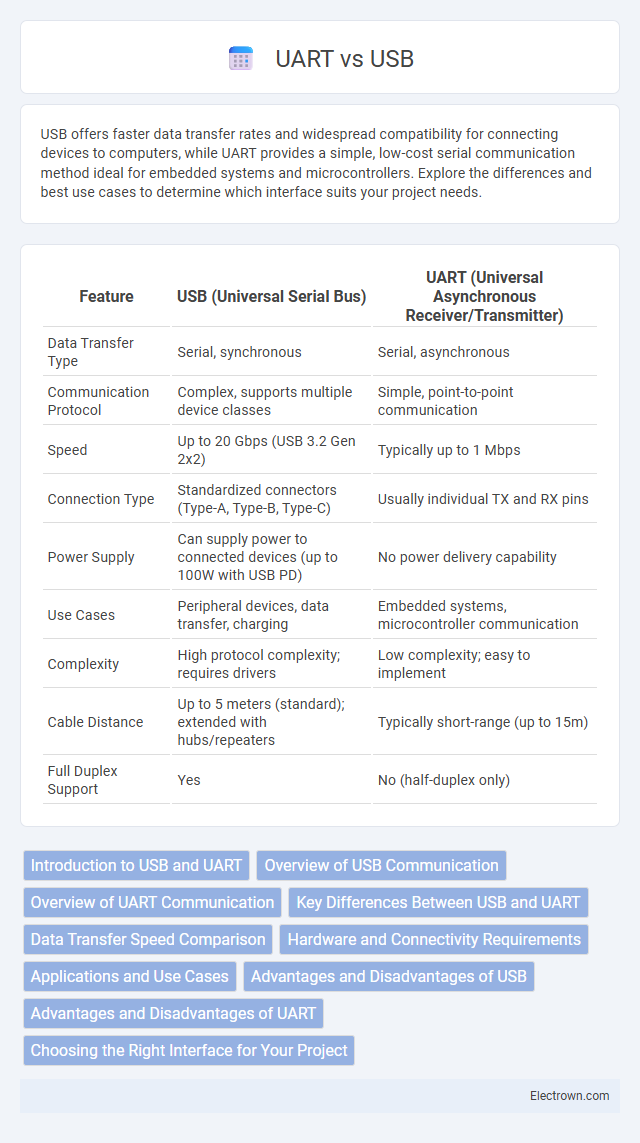USB offers faster data transfer rates and widespread compatibility for connecting devices to computers, while UART provides a simple, low-cost serial communication method ideal for embedded systems and microcontrollers. Explore the differences and best use cases to determine which interface suits your project needs.
Table of Comparison
| Feature | USB (Universal Serial Bus) | UART (Universal Asynchronous Receiver/Transmitter) |
|---|---|---|
| Data Transfer Type | Serial, synchronous | Serial, asynchronous |
| Communication Protocol | Complex, supports multiple device classes | Simple, point-to-point communication |
| Speed | Up to 20 Gbps (USB 3.2 Gen 2x2) | Typically up to 1 Mbps |
| Connection Type | Standardized connectors (Type-A, Type-B, Type-C) | Usually individual TX and RX pins |
| Power Supply | Can supply power to connected devices (up to 100W with USB PD) | No power delivery capability |
| Use Cases | Peripheral devices, data transfer, charging | Embedded systems, microcontroller communication |
| Complexity | High protocol complexity; requires drivers | Low complexity; easy to implement |
| Cable Distance | Up to 5 meters (standard); extended with hubs/repeaters | Typically short-range (up to 15m) |
| Full Duplex Support | Yes | No (half-duplex only) |
Introduction to USB and UART
USB (Universal Serial Bus) is a widely used communication protocol designed for high-speed data transfer and device connectivity, supporting plug-and-play functionality and power supply over a single cable. UART (Universal Asynchronous Receiver/Transmitter) is a simpler, hardware-based serial communication interface commonly used for short-distance, low-speed, and point-to-point data exchange between microcontrollers and peripheral devices. Understanding the differences in speed, complexity, and application scenarios helps you choose the right protocol for your embedded systems or device communication needs.
Overview of USB Communication
USB communication enables high-speed, plug-and-play data transfer between devices using a standardized protocol supporting multiple device classes. Unlike UART, USB supports complex data streams with built-in error detection, power management, and device enumeration, making it ideal for modern peripherals. Your choice depends on the need for speed, complexity, and device compatibility, as USB excels in versatility and scalability.
Overview of UART Communication
UART communication is a serial protocol that transmits data bit by bit using two lines: transmit (TX) and receive (RX), enabling full-duplex communication. It operates asynchronously, relying on a predefined baud rate to synchronize data transfer without a clock signal. Commonly used in microcontrollers and embedded systems, UART provides simple, low-cost, and reliable short-distance communication compared to USB's complex protocol and higher data rates.
Key Differences Between USB and UART
USB and UART differ significantly in data transfer protocols and physical interfaces, with USB supporting higher data rates up to 10 Gbps and complex communication through standardized protocols, while UART operates with simpler serial communication at lower speeds typically up to 1 Mbps. USB provides plug-and-play connectivity with power delivery and device enumeration, whereas UART requires dedicated pins for transmit and receive signals and lacks built-in power support. Your choice between USB and UART depends on the need for speed, complexity, and device compatibility in your communication setup.
Data Transfer Speed Comparison
USB offers significantly higher data transfer speeds compared to UART, with USB 3.0 supporting rates up to 5 Gbps, whereas traditional UART typically maxes out around 115.2 Kbps to 1 Mbps. This vast difference makes USB ideal for high-speed data communication and multimedia applications, while UART remains suitable for simple serial communication in embedded systems. The disparity in speed is due to USB's complex protocol and hardware support, which facilitates faster and more reliable data transmission.
Hardware and Connectivity Requirements
USB requires a dedicated controller chip and supports plug-and-play connectivity with standardized cables and connectors, making it ideal for complex devices needing high-speed data transfer. UART relies on a simpler hardware setup with just a transmitter and receiver for asynchronous serial communication, often requiring custom wiring between devices. Your choice depends on whether you need the robust, universally compatible USB infrastructure or the minimalistic, direct connection style of UART.
Applications and Use Cases
USB interfaces dominate in consumer electronics, enabling fast data transfer and device charging for peripherals like keyboards, mice, and external storage. UART is widely used in embedded systems and microcontroller communication due to its simplicity and low hardware requirements in applications such as sensor data exchange and serial debugging. Industrial automation and IoT devices often combine UART for internal device communication and USB for user interface connectivity, optimizing cost and efficiency.
Advantages and Disadvantages of USB
USB offers high data transfer speeds, widespread compatibility with numerous devices, and ease of use through plug-and-play functionality, making it ideal for everyday consumer electronics. However, USB requires more complex hardware and software support, higher power consumption, and can introduce latency compared to the simplicity and lower power draw of UART communication. Your choice depends on whether you prioritize speed and versatility or simplicity and direct serial communication.
Advantages and Disadvantages of UART
UART offers simple, low-cost serial communication with minimal hardware requirements, making it ideal for embedded systems and microcontroller interfaces. Its disadvantages include limited data transfer speeds compared to USB and lack of standardized connectors, which can complicate interoperability and increase susceptibility to noise in long-distance transmissions. UART's point-to-point communication restricts network scalability, unlike USB that supports multiple devices through hubs.
Choosing the Right Interface for Your Project
When choosing the right interface for your project, USB offers high-speed data transfer and widespread compatibility with modern devices, making it ideal for applications requiring fast communication and plug-and-play functionality. UART is preferred for simple, low-speed, and long-distance serial communication in embedded systems due to its straightforward design and minimal hardware requirements. Consider your project's data rate, distance, and device compatibility to determine whether USB or UART best suits your development needs.
USB vs UART Infographic

 electrown.com
electrown.com